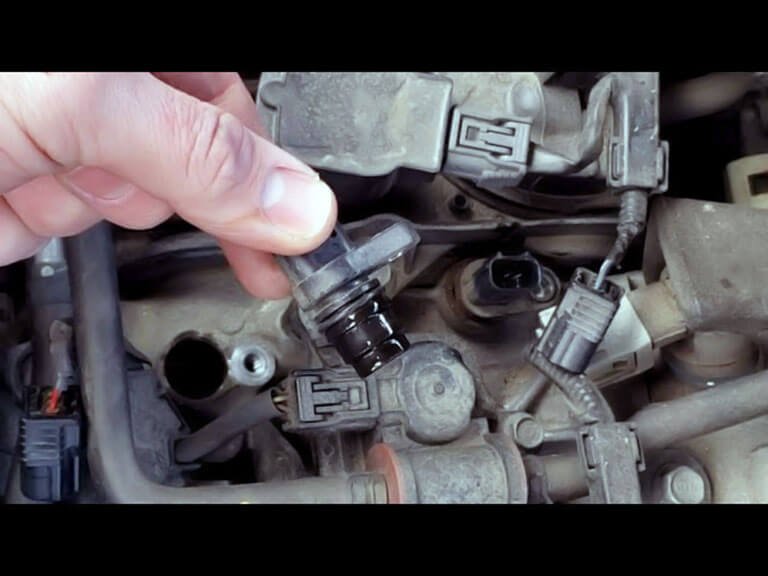Camshaft Position Sensor Problems: Quick Fixes & Tips
Camshaft position sensor problems often lead to poor engine performance and increased fuel consumption. A faulty sensor can trigger warning lights and cause misfires.
The camshaft position sensor plays a crucial role in engine management. It monitors the position of the camshaft, helping the engine control unit (ECU) optimize timing for fuel injection and ignition. When this sensor malfunctions, drivers may experience rough idling, decreased acceleration, or even stalling.
Common symptoms include check engine lights, erratic engine behavior, and inconsistent fuel efficiency. Identifying and addressing these issues promptly is vital for maintaining optimal vehicle performance. Regular maintenance and timely diagnostics can prevent long-term damage and costly repairs. Understanding these problems can empower drivers to make informed decisions regarding vehicle care.
Symptoms Of A Faulty Camshaft Position Sensor

A faulty camshaft position sensor can lead to various issues in your vehicle. Recognizing the symptoms early can save you time and money. Here are the common signs that indicate a problem.
Engine Misfires And Vibrations
Engine misfires and vibrations are significant indicators of a faulty camshaft position sensor. These symptoms can occur due to incorrect timing in the engine’s operation.
- Unstable engine idle
- Sudden power loss during acceleration
- Strange noises from the engine
Misfires happen when the fuel-air mixture in the cylinders fails to ignite correctly. This can lead to:
- Increased emissions
- Rough driving experience
- Potential engine damage
Poor Fuel Economy And Power Loss
A faulty camshaft position sensor can lead to poor fuel economy. The engine may not run efficiently, causing increased fuel consumption.
| Symptoms | Effects |
|---|---|
| Poor fuel economy | Higher fuel costs |
| Power loss | Difficulty in acceleration |
Drivers may notice:
- Frequent trips to the gas station
- Decrease in overall vehicle performance
- Unresponsive throttle
Diagnosing Camshaft Position Sensor Issues
Diagnosing camshaft position sensor problems is essential for vehicle performance. A faulty sensor can lead to poor engine performance and increased emissions. Understanding how to identify issues helps in timely repairs.
Error Codes And Check Engine Light
The check engine light can signal a camshaft position sensor issue. Error codes provide clues about the problem. Some common codes include:
| Error Code | Description |
|---|---|
| P0340 | Camshaft Position Sensor Circuit Malfunction |
| P0341 | Camshaft Position Sensor Range/Performance Problem |
| P0342 | Camshaft Position Sensor Low Input |
Use an OBD-II scanner to read these codes. Once you have the codes, check for other issues in the engine. Fixing the underlying problems can sometimes resolve the sensor issue.
Visual Inspection And Testing
A visual inspection is a simple way to start diagnosing sensor problems. Check these components:
- Wiring and connectors
- Sensor mounting
- Signs of wear or damage
Look for frayed wires or loose connections. These can cause inaccurate readings. Testing the sensor can confirm if it’s working properly. Follow these steps:
- Disconnect the sensor.
- Use a multimeter to check resistance.
- Compare readings to the manufacturer’s specifications.
Replace the sensor if the readings are outside the normal range. Early diagnosis can prevent further engine damage.
Quick Fixes For Camshaft Sensor Problems
Camshaft position sensor issues can disrupt your engine’s performance. Quick fixes can save time and money. Here are two effective methods to troubleshoot these problems.
Cleaning The Sensor
Dirty sensors can cause incorrect readings. A simple cleaning can help restore function.
- Turn off the engine.
- Disconnect the battery.
- Locate the camshaft position sensor.
- Use a clean cloth or brush. Remove dirt and debris.
- Reconnect the sensor.
- Reconnect the battery.
- Start the engine. Check if the issue is resolved.
Reconnecting Loose Wires
Loose or damaged wires can disrupt the sensor’s performance. Proper connections are vital.
- Inspect wiring harness. Look for loose connections.
- Check for frayed or damaged wires.
- Reconnect any loose wires. Ensure a tight fit.
- Replace any damaged wires. Use electrical tape if needed.
- Start the engine. Test for proper operation.
| Issue | Quick Fix |
|---|---|
| Dirty sensor | Clean with cloth or brush |
| Loose wires | Reconnect and secure |
| Damaged wires | Replace or tape up |
These quick fixes can help resolve camshaft position sensor problems. Regular maintenance keeps your engine running smoothly.
When To Replace The Camshaft Position Sensor
The camshaft position sensor plays a crucial role in engine performance. It helps the engine control unit (ECU) determine the correct timing for fuel injection and ignition. Malfunctioning sensors can cause serious issues. Understanding when to replace this part is essential for maintaining vehicle health.
Lifespan Of A Sensor
Most camshaft position sensors last between 60,000 to 100,000 miles. Various factors affect their lifespan:
- Driving conditions
- Engine heat
- Vibration from the engine
- Quality of the sensor
Signs that your sensor may need replacement include:
- Check engine light activation
- Rough idling
- Difficulty starting the engine
- Decreased fuel efficiency
Choosing The Right Replacement
Selecting the right camshaft position sensor is vital. Follow these steps:
- Check the vehicle’s manual for specifications.
- Choose sensors from reputable brands.
- Consider OEM (Original Equipment Manufacturer) parts for reliability.
Compare the following factors:
| Factor | OEM Parts | Aftermarket Parts |
|---|---|---|
| Quality | High | Varies |
| Price | Higher | Lower |
| Warranty | Often included | Varies by manufacturer |
Purchasing the right replacement ensures optimal engine performance and longevity.
Step-by-step Guide To Replacing The Sensor
Replacing the camshaft position sensor is crucial for your engine’s performance. This guide simplifies the process. Follow these steps for a smooth replacement.
Gathering Necessary Tools
Before starting, gather these essential tools:
- Wrench set
- Socket set
- Screwdriver set
- Ratchet
- Torque wrench
- Safety goggles
- Gloves
- Replacement camshaft position sensor
Installation Process
Follow this step-by-step guide for installation:
- Disconnect the battery: Remove the negative terminal.
- Locate the sensor: Find it on the engine block.
- Remove the connector: Gently pull the wiring harness off.
- Unscrew the old sensor: Use a socket or wrench.
- Install the new sensor: Screw it in securely.
- Reconnect the wiring harness: Push it until it clicks.
- Reconnect the battery: Attach the negative terminal.
- Test the engine: Start the car to check functionality.
Follow these steps carefully. Ensure all connections are secure. This will help avoid future issues.
Calibrating The New Camshaft Position Sensor
Calibrating the new camshaft position sensor is crucial. Proper calibration ensures accurate readings. This enhances engine performance and efficiency.
Importance Of Calibration
Calibration plays a vital role in your vehicle’s operation. Here are some key points:
- Accuracy: Proper calibration ensures the sensor reads accurately.
- Performance: A well-calibrated sensor improves engine performance.
- Efficiency: It helps in better fuel efficiency and reduced emissions.
- Longevity: Correct calibration can extend the lifespan of your engine.
How To Calibrate
Follow these steps to calibrate your camshaft position sensor:
- Disconnect the Battery: Always start by disconnecting the battery.
- Remove the Sensor: Carefully take out the old sensor.
- Install the New Sensor: Place the new sensor in the same position.
- Reconnect the Battery: Reattach the battery cables securely.
- Use a Diagnostic Tool: Connect a diagnostic scanner to the vehicle.
- Follow On-Screen Instructions: Use the tool to calibrate the sensor.
- Test the Vehicle: Start the engine and check for error codes.
Calibration may vary by vehicle. Always refer to the vehicle’s manual. This ensures you follow specific instructions for your model.
Remember, taking the time to calibrate correctly will save you money and hassle later.
Preventative Maintenance To Avoid Future Issues
Regular maintenance can help you avoid camshaft position sensor problems. Simple steps can keep your vehicle running smoothly. Follow these tips to prevent future issues.
Regular Check-ups
Schedule regular check-ups for your vehicle. Professionals can spot problems early. Here are key benefits of regular check-ups:
- Early detection of sensor issues.
- Improved vehicle performance.
- Longer lifespan of your engine components.
During check-ups, technicians should test the camshaft position sensor. They can also inspect the wiring and connectors. This keeps everything in good shape.
Keeping The Sensor Area Clean
Keeping the sensor area clean is crucial. Dirt and debris can cause sensor malfunction. Follow these steps to maintain cleanliness:
- Check the sensor area regularly.
- Use a soft brush to remove dirt.
- Wipe the area with a clean cloth.
- Inspect for any leaks or cracks.
Use a mild cleaner if necessary. Avoid harsh chemicals that can damage the sensor. A clean sensor area improves its accuracy and function.
Professional Help Vs. Diy
Deciding between professional help and DIY for camshaft position sensor issues can be tough. Each option has its advantages and challenges. Understanding when to seek help or tackle the problem yourself is essential.
When To Seek Professional Help
Some situations call for expert assistance. Here are key signs to consider:
- Complex Symptoms: If your engine shows multiple issues, consult a professional.
- Advanced Diagnostics: Specialized tools may be necessary for accurate diagnosis.
- Warranty Concerns: Repairs might void your vehicle’s warranty if not done correctly.
- Safety Risks: If repairs involve critical components, safety must come first.
Benefits Of Diy
Taking on camshaft position sensor problems yourself can be rewarding. Here are some benefits:
- Cost Savings: Avoid expensive labor costs.
- Learning Experience: Gain valuable knowledge about your vehicle.
- Flexibility: Work on your schedule without rushing.
- Satisfaction: Enjoy the pride of fixing your own car.
Before diving into a DIY project, assess your skills and tools. Simple repairs can often be done with basic tools and online guides. Make sure to research thoroughly. Safety should always be a priority.
Understanding The Role Of The Camshaft Position Sensor
The Camshaft Position Sensor plays a vital role in modern engines. It helps manage engine timing and performance. Understanding its functions can help identify potential problems.
Function In Engine Timing
The Camshaft Position Sensor tracks the camshaft’s position. This information is crucial for the engine’s timing system. It ensures that fuel injection and ignition occur at the right moments.
- Monitors camshaft rotation.
- Provides data to the Engine Control Unit (ECU).
- Helps in synchronizing the crankshaft and camshaft.
Without this sensor, the engine may misfire or stall. It can also affect fuel efficiency. A malfunctioning sensor can lead to serious engine issues.
Impact On Vehicle Performance
A faulty Camshaft Position Sensor can cause numerous performance issues. Drivers may experience rough idling, reduced power, or poor acceleration.
| Symptoms of a Faulty Sensor | Impact on Performance |
|---|---|
| Rough idling | Unstable engine performance |
| Engine stalling | Loss of power while driving |
| Poor fuel economy | Increased fuel consumption |
Ignoring these symptoms can lead to costly repairs. Regular maintenance checks can prevent sensor-related issues. Understanding the sensor’s role helps maintain optimal vehicle performance.
Troubleshooting Tips For Persistent Sensor Problems
Camshaft position sensors can cause engine trouble. Issues with these sensors often lead to poor performance. Troubleshooting can save time and money. Here are some tips to help you diagnose persistent sensor problems.
Common Mistakes To Avoid
Many people make mistakes while troubleshooting camshaft position sensors. Avoid these common errors:
- Ignoring Diagnostic Codes: Always check for error codes.
- Overlooking Wiring Issues: Inspect wires and connectors carefully.
- Not Testing Continuity: Use a multimeter to test sensor continuity.
- Assuming Sensor Failure: Rule out other engine problems first.
- Skipping Visual Inspections: Look for dirt or damage.
Advanced Diagnostic Techniques
Some problems require advanced diagnostics. Use these techniques for better results:
| Technique | Description |
|---|---|
| Oscilloscope Testing | Measures waveform signals from the sensor. |
| OBD-II Scanner | Reads error codes and live data. |
| Voltage Testing | Checks voltage at the sensor connector. |
| Scan Tool Analysis | Provides detailed sensor data and performance. |
Use these techniques to pinpoint the issue accurately. Identify the root cause effectively. This leads to better repairs and fewer headaches.
Frequently Asked Questions
What Are Common Camshaft Position Sensor Symptoms?
Common symptoms include poor engine performance, stalling, and difficulty starting the engine.
How To Diagnose Camshaft Position Sensor Issues?
Use an OBD-II scanner to check for error codes and inspect the wiring for damage or corrosion.
Can A Faulty Camshaft Sensor Cause Misfires?
Yes, a faulty sensor can disrupt timing, leading to engine misfires and rough idling.
How Much Does It Cost To Replace A Camshaft Sensor?
Replacement costs typically range from $100 to $300, depending on the vehicle and labor rates.
What Happens If You Ignore Camshaft Sensor Problems?
Ignoring issues can lead to severe engine damage, reduced fuel efficiency, and increased repair costs.
Conclusion
Camshaft position sensor issues can lead to various engine problems. Recognizing the symptoms early can save you time and money. Regular maintenance and timely replacements are key to preventing further damage. Stay informed about your vehicle’s needs to ensure optimal performance.
A little attention goes a long way in automotive care.






